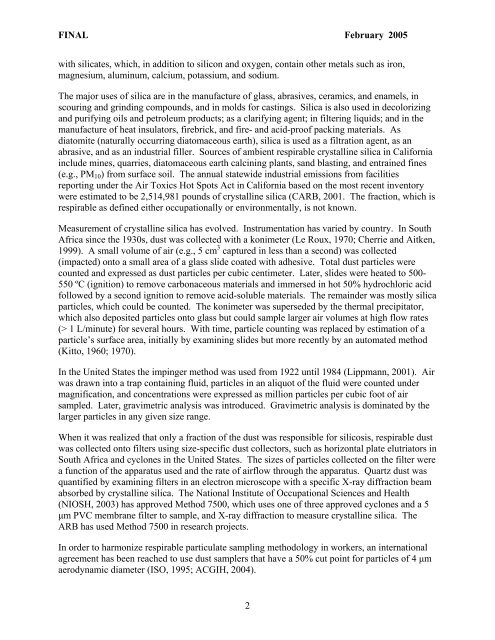Silica (crystalline, respirable) - OEHHA
Silica (crystalline, respirable) - OEHHA
Silica (crystalline, respirable) - OEHHA
You also want an ePaper? Increase the reach of your titles
YUMPU automatically turns print PDFs into web optimized ePapers that Google loves.
FINAL February 2005<br />
with silicates, which, in addition to silicon and oxygen, contain other metals such as iron,<br />
magnesium, aluminum, calcium, potassium, and sodium.<br />
The major uses of silica are in the manufacture of glass, abrasives, ceramics, and enamels, in<br />
scouring and grinding compounds, and in molds for castings. <strong>Silica</strong> is also used in decolorizing<br />
and purifying oils and petroleum products; as a clarifying agent; in filtering liquids; and in the<br />
manufacture of heat insulators, firebrick, and fire- and acid-proof packing materials. As<br />
diatomite (naturally occurring diatomaceous earth), silica is used as a filtration agent, as an<br />
abrasive, and as an industrial filler. Sources of ambient <strong>respirable</strong> <strong>crystalline</strong> silica in California<br />
include mines, quarries, diatomaceous earth calcining plants, sand blasting, and entrained fines<br />
(e.g., PM10) from surface soil. The annual statewide industrial emissions from facilities<br />
reporting under the Air Toxics Hot Spots Act in California based on the most recent inventory<br />
were estimated to be 2,514,981 pounds of <strong>crystalline</strong> silica (CARB, 2001. The fraction, which is<br />
<strong>respirable</strong> as defined either occupationally or environmentally, is not known.<br />
Measurement of <strong>crystalline</strong> silica has evolved. Instrumentation has varied by country. In South<br />
Africa since the 1930s, dust was collected with a konimeter (Le Roux, 1970; Cherrie and Aitken,<br />
1999). A small volume of air (e.g., 5 cm 3 captured in less than a second) was collected<br />
(impacted) onto a small area of a glass slide coated with adhesive. Total dust particles were<br />
counted and expressed as dust particles per cubic centimeter. Later, slides were heated to 500-<br />
550 ºC (ignition) to remove carbonaceous materials and immersed in hot 50% hydrochloric acid<br />
followed by a second ignition to remove acid-soluble materials. The remainder was mostly silica<br />
particles, which could be counted. The konimeter was superseded by the thermal precipitator,<br />
which also deposited particles onto glass but could sample larger air volumes at high flow rates<br />
(> 1 L/minute) for several hours. With time, particle counting was replaced by estimation of a<br />
particle’s surface area, initially by examining slides but more recently by an automated method<br />
(Kitto, 1960; 1970).<br />
In the United States the impinger method was used from 1922 until 1984 (Lippmann, 2001). Air<br />
was drawn into a trap containing fluid, particles in an aliquot of the fluid were counted under<br />
magnification, and concentrations were expressed as million particles per cubic foot of air<br />
sampled. Later, gravimetric analysis was introduced. Gravimetric analysis is dominated by the<br />
larger particles in any given size range.<br />
When it was realized that only a fraction of the dust was responsible for silicosis, <strong>respirable</strong> dust<br />
was collected onto filters using size-specific dust collectors, such as horizontal plate elutriators in<br />
South Africa and cyclones in the United States. The sizes of particles collected on the filter were<br />
a function of the apparatus used and the rate of airflow through the apparatus. Quartz dust was<br />
quantified by examining filters in an electron microscope with a specific X-ray diffraction beam<br />
absorbed by <strong>crystalline</strong> silica. The National Institute of Occupational Sciences and Health<br />
(NIOSH, 2003) has approved Method 7500, which uses one of three approved cyclones and a 5<br />
µm PVC membrane filter to sample, and X-ray diffraction to measure <strong>crystalline</strong> silica. The<br />
ARB has used Method 7500 in research projects.<br />
In order to harmonize <strong>respirable</strong> particulate sampling methodology in workers, an international<br />
agreement has been reached to use dust samplers that have a 50% cut point for particles of 4 µm<br />
aerodynamic diameter (ISO, 1995; ACGIH, 2004).<br />
2















